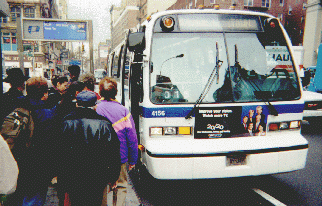|
Schaller Consulting Archive |
 |
| Home | Press | Publications | Taxi Research |
By Bruce Schaller
Published in New York Transportation Journal, Fall/Winter 1998
When the Metropolitan Transportation Authority (MTA) announced plans to install a $700 million automatic fare collection system in 1991, MTA officials hailed the new system as having "the potential to revolutionize public transportation" in New York City through fare discounts and better integration between transportation modes. Automatic fare collection would attract additional customers and change the way New Yorkers regarded their venerable transit system. New turnstiles were also expected to drastically reduce fare evasion that was draining the system of millions of dollars a year.
The revolution did not happen overnight, however. MetroCard usage had risen to only 15% of weekday transit trips as the last of the new fare-collection equipment was installed in Spring 1997. And only in mid-1997 was the MTA able to offer the fare incentives at the heart of its original vision.
With the new system and fare incentives in place, the revolution did come.
Representing fulfillment of the MTA's original vision, these results are impressive but not surprising. What is surprising is the size of ridership growth and which fare policies had the greatest impact. This part of the story carries significant lessons for how to further build transit ridership in New York City.
The first surprise was that transit ridership flourished with introduction of free bus-and-subway transfers in July 1997. While clearly important to the 9% of subway riders living in two-fare zones, free transfers were not expected to have a widespread impact on ridership or MetroCard usage among customers who rarely transfer between bus and subway.
 In fact, in the second half of 1997:
In fact, in the second half of 1997:
In addition, one of the most remarkable and pleasing developments was that despite the popularity of free transfers, fare revenues dropped less than expected.
The significance of free transfers' effect on ridership and MetroCard usage is highlighted by comparing customers' response to free transfers with their response to the 11 for 10 bonus program introduced in January 1998. The bonus produced smaller increases in ridership for both subway and bus than did free transfers. MetroCard usage rose modestly, from 59% market share at the end of 1997 to 70% at mid-year. Among the public and press, free transfers seemed to make a much bigger splash than the bonus.
What explains these results? Why did free transfers prove to be such a big hit?
The explanation appears to lie in the fact that free transfers combined intangible benefits with a fare incentive. Ridership projections had been based on previous experience with across-the-board fare changes. Actual ridership growth was greater than models predicted because free transfers added to the equation factors that are very important to consumers-convenience, flexibility and simplicity. Free transfers provide the flexibility to hop on a bus at unplanned moments. They created a catalyst for subway riders to "discover" bus service. And free transfers mean that there is less to worry about when customers plan a trip.
The experience with free transfers shows that making transit more convenient, flexible and easy to use pays off in tangible ridership gains. This experience was repeated with introduction of transit passes in July 1998.
The new Unlimited ride passes also generated customer enthusiasm with their combination of a fare incentive and convenience and flexibility. As with free transfers, revenue loss to NYC Transit was less than forecast despite unexpectedly vigorous sales of the passes. Evidently, passes attracted not just those already making enough trips to save money with a pass, but also attracted customers just below the break-even threshold (13 trips for the 7-day pass and 11 trips for the 30-day pass). These customers have taken advantage of passes to boost their ridership past the break-even point-making transit cheaper for them while increasing NYC Transit revenues. Some transit riders also report that pass usage cut into their taxi ridership, an unsurprising development since pass users' incremental transit trips are free.
What are the lessons from New York's introduction of automated fare collection and innovative fare policies? As expected, one main lesson is that MetroCard is about a lot more than just the fare. Bringing late-20th Century technology to the nearly century-old transit system has increased customers' flexibility, convenience and ease of use.
The powerful impact of combining convenience with fare incentives also suggests that convenience can make a difference in other areas as well. For example, new IRT subway cars on order include customer conveniences such as wider doors, electronic strip maps, pre-recorded crystal-clear announcements and seats designed for New Yorkers' variable widths. Modernized subway signal systems and new vehicle-location devices on buses will give customers information about next train and bus arrivals. These and other steps, like MetroCard and fare incentives, can be expected to continue to make urban transit an attractive, competitive mode of transportation in a world where convenience and ease of use are increasingly prized.
Home
|
Press
|
Publications
|
Taxi
Research
|